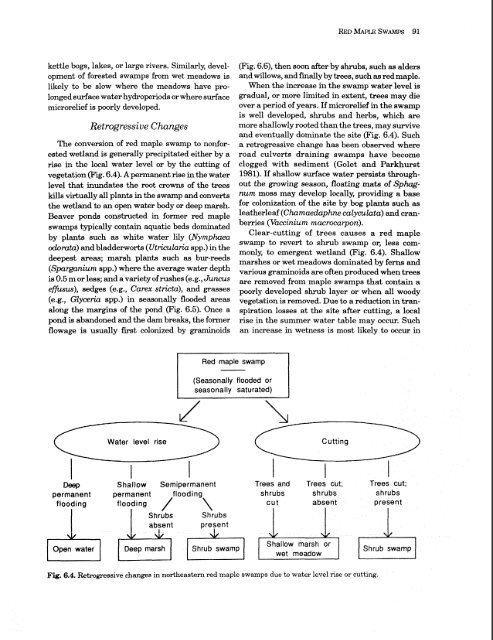Ecology of Red Maple Swamps in the Glaciated Northeast: A ...
Ecology of Red Maple Swamps in the Glaciated Northeast: A ...
Ecology of Red Maple Swamps in the Glaciated Northeast: A ...
You also want an ePaper? Increase the reach of your titles
YUMPU automatically turns print PDFs into web optimized ePapers that Google loves.
kettle bogs, lakes, or large rivers. Similarly, development<br />
<strong>of</strong> forested swamps from wet meadows is<br />
likely to be slow where <strong>the</strong> meadows have prolonged<br />
surface water hydroperiods or where surface<br />
microrelief is poorly developed.<br />
Retrogressive Changes<br />
The conversion <strong>of</strong> red maple swamp to nonforested<br />
wetland is generally precipitated ei<strong>the</strong>r by a<br />
rise <strong>in</strong> <strong>the</strong> local water level or by <strong>the</strong> cutt<strong>in</strong>g <strong>of</strong><br />
vegetation (Fig. 6.4). A permanent rise <strong>in</strong> <strong>the</strong> water<br />
level that <strong>in</strong>undates <strong>the</strong> root crowns <strong>of</strong> <strong>the</strong> trees<br />
kills virtually all plants <strong>in</strong> <strong>the</strong> swamp and converts<br />
<strong>the</strong> wetland to an open water body or deep marsh.<br />
Beaver ponds constructed <strong>in</strong> former red maple<br />
swamps typically conta<strong>in</strong> aquatic beds dom<strong>in</strong>ated<br />
by plants such as white water lily (Nymphaea<br />
dmta) and bladdenvorta (Utricularia spp.) <strong>in</strong> <strong>the</strong><br />
deepest areas; marsh plants such as bur-reeds<br />
(Sparganium spp.) where <strong>the</strong> average water depth<br />
is 0.5 m or less; and a variety <strong>of</strong> rushes (e.g., Juncus<br />
emus), sedges (e.g., Carex stricta), and grasses<br />
(e.g., Glycericl, spp.) <strong>in</strong> seasonally flooded areas<br />
along <strong>the</strong> marg<strong>in</strong>s <strong>of</strong> <strong>the</strong> pond (Fig. 6.5). Once a<br />
pond is abandoned and <strong>the</strong> dam breaks, <strong>the</strong> former<br />
flowage is usually first colonized by gram<strong>in</strong>oids<br />
(Fig. 6.6)) <strong>the</strong>n soon after by shrubs, such as alders<br />
and willows, and fmally by trees, such as red maple.<br />
When <strong>the</strong> <strong>in</strong>crease <strong>in</strong> <strong>the</strong> swamp water level is<br />
gradual, or more limited <strong>in</strong> extent, trees may die<br />
over a period <strong>of</strong> years. If microrelief <strong>in</strong> <strong>the</strong> swamp<br />
is well developed, shrubs and herbs, which are<br />
more shallowly rooted than <strong>the</strong> trees, may survive<br />
and eventually dom<strong>in</strong>ate <strong>the</strong> site (Fig. 6.4). Such<br />
a retrogressive change has been observed where<br />
road culverts dra<strong>in</strong><strong>in</strong>g swamps have become<br />
clogged with sediment (Golet and Parkhurst<br />
1981). If shallow surface water persists throughout<br />
<strong>the</strong> grow<strong>in</strong>g season, float<strong>in</strong>g mats <strong>of</strong> Sphagnum<br />
moss may develop locally, provid<strong>in</strong>g a base<br />
for colonization <strong>of</strong> <strong>the</strong> site by bog plants such as<br />
lea<strong>the</strong>rleaf (Chamaeduphne calyculata) and cranberries<br />
(Vacc<strong>in</strong>ium macrocarpon).<br />
Clear-cutt<strong>in</strong>g <strong>of</strong> trees causes a red maple<br />
swamp to revert to shrub swamp or, less commonly,<br />
to emergent wetland (Fig. 6.4). Shallow<br />
marshes or wet meadows dom<strong>in</strong>ated by ferns and<br />
various gram<strong>in</strong>oids are <strong>of</strong>ten produced when trees<br />
are removed from maple swamps that conta<strong>in</strong> a<br />
poorly developed shrub layer or when all woody<br />
vegetation is removed. Due to a reduction <strong>in</strong> transpiration<br />
losses at <strong>the</strong> site after cutt<strong>in</strong>g, a local<br />
rise <strong>in</strong> <strong>the</strong> summer water table may occur. Such<br />
an <strong>in</strong>crease <strong>in</strong> wetness is most likely to occur <strong>in</strong><br />
I<br />
<strong>Red</strong> maple swamp<br />
I<br />
(Seasonally flooded or<br />
seasonally saturated)<br />
Water level rise<br />
I<br />
Shallow Semipermanent Trees and Trees cut; Trees cut;<br />
permanent shrubs shrubs shrubs<br />
flood<strong>in</strong>g cut absent present<br />
Shrubs<br />
present<br />
Open water<br />
Deep marsh<br />
Fig. 6.4. Retrogressive changes <strong>in</strong> nor<strong>the</strong>astern red maple swamps due to water level rise or cutt<strong>in</strong>g.

















